Kutya Éji Dala
 :: If someone had told you in, like, 1983 that this was already the last feature film by this extremely talented revolutionary and new and young artist, Gabor Body you'd have been just shocked like a child finding out that her parents are never to come home again because they had this thing, this accident or what: a string of characters carrying the darkest poison. But since as long as you promise you won't touch anything times with all those layers are everlasting, they are there for you and we can just make a jump - like pushing the arm of a turntable back to any beautiful moment of all. What an opportunity! What a trip - already!
:: If someone had told you in, like, 1983 that this was already the last feature film by this extremely talented revolutionary and new and young artist, Gabor Body you'd have been just shocked like a child finding out that her parents are never to come home again because they had this thing, this accident or what: a string of characters carrying the darkest poison. But since as long as you promise you won't touch anything times with all those layers are everlasting, they are there for you and we can just make a jump - like pushing the arm of a turntable back to any beautiful moment of all. What an opportunity! What a trip - already!
What a fresh day! Usually you just don't like being told that this and that movie (film as we used to call them) is very-very good. Hungarian Cinema was already at its highest of the 80's and you have seen like a lot of these new Hungarian films, many of which you liked a lot. They were funny, interesting, sometimes stirring - but in any circumstances they were opening windows to reality. Yes, you'd already say "I like these new Hungarian films". There was however an even newer thing that you had to hear a lot mentioning. All your older friends would be talking about this brand new artist: Gabor Body - whose films are like ... like nothing could compare to them. All these guys were like those in the Dune who came back from the desert and kept saying: Muad'Dib, Muad'Dib. That was Gabor Body.
It was a short trip by train. Like 12 minutes. Still it was another town and trains would not go but like every hour or so. We were just taking this train to go over there and do something - have a beer or so. Luckily we met this wonderful guy Rob and his friend Attila. They were on this train too drinking beers onboard and being in a funloving cheerful mood. They said they'd already had one each and that they were going to see the Dog's Night Song. It was a beautiful afternoon. At that moment you couldn't tell that you'd remember it for the rest of your life. We were like 20-30 minutes late. We were just dropped into the very middle of it: you sow the couple having the fight in the red light under the apple tree. Yes, we were there in the very middle. 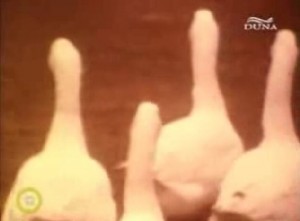 Then you sow Super-8 footages with some extremely good music in the background - "Europa ist Amerika"- like Kraftwerk. It was so .... so .. N-E-W you know! You felt so thrilled and amazed! You just happened to have drunk from something so far unknown the taste of which you'd simply never forget - never want to forget. So sweet and so deep. Coming out from that cinema it was still light outside - we didn't know what we'd just seen but we were absolutely positive that it was totally and incredibly amazing! It was not just another "window" to reality. It was not just another window to reality. It'd make you feel so dragged behind like having to watch the world thru a window only. It's just make you wanna jump! Forget all the layers of glass that's keeping you out and take a dive into the depths and myths of reality.
Then you sow Super-8 footages with some extremely good music in the background - "Europa ist Amerika"- like Kraftwerk. It was so .... so .. N-E-W you know! You felt so thrilled and amazed! You just happened to have drunk from something so far unknown the taste of which you'd simply never forget - never want to forget. So sweet and so deep. Coming out from that cinema it was still light outside - we didn't know what we'd just seen but we were absolutely positive that it was totally and incredibly amazing! It was not just another "window" to reality. It was not just another window to reality. It'd make you feel so dragged behind like having to watch the world thru a window only. It's just make you wanna jump! Forget all the layers of glass that's keeping you out and take a dive into the depths and myths of reality.
What did you just see? A ghost perhaps - like Hamlet did? What was this film about? What was the story? Why did it make you so enthusiastic? Well, for some people it's just a film - that's okay and you couldn't make this change anyways. Now - like 26 years later (!) - it'd be even an extra trillion times more difficult to talk about it trying to enlighten what a remarkably unique and beautiful piece of art this film is - it would be totally hopeless ... unless ... Unless you have seen it too with your own eyes :) Watching a Godard film like the ever so beautiful Masculine-Feminine is way less difficult since the reality of France in the 60's is a legitimate layer of time - and still recollectable unlike that of Hungary, Budapest in the 80's - which belong to an ungraspable absurd world that sank a long time ago.
Still, to get a clue of how extraordinarily wonderful film the Dog's Night Song was (is) we only have to think of the fact that after this film just about everybody wanted to make something like it. It was there and anybody could copy it any possible ways and yet nobody for the rest of the 80's and for the whole 90's could even get close to making a film like this. Nor making a film as good as this is. How can this be? What's the secret? A new technique perhaps?:) Yes, sort of:)
:: film's 3rd dimension
Gabor Body was not a filmmaker in the traditional / industrial sense of the word. Filmmaking traditionally or by default means something lie playing football: there's a certain size of playground, certain rules of the game within which the spectacle takes place. Like a curtain framed stage in a garden where they'll perform a small play in the afternoon (in Tschechow's SeaGull - within the play). 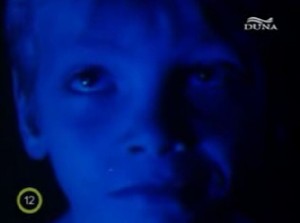 Gabor Body simply was not focusing on this stage in the garden - but he was actually interested in the play in the wider sense - that is the SeaGull itself. For him film was a medium, okay, "a thing" by which he could draw signs - and not a way of transportation like taking the subway or a tram or going by car, not "a thing" within which he was thinking in order to express himself by its means. Film was a brush in his hand by which he could create exciting things - and not a room to move in and speak the language of that room and speak out of that box. He didn't think "within film" - he was rather using film to think thru it. He didn' think "within film" but used film for his thinking.
Gabor Body simply was not focusing on this stage in the garden - but he was actually interested in the play in the wider sense - that is the SeaGull itself. For him film was a medium, okay, "a thing" by which he could draw signs - and not a way of transportation like taking the subway or a tram or going by car, not "a thing" within which he was thinking in order to express himself by its means. Film was a brush in his hand by which he could create exciting things - and not a room to move in and speak the language of that room and speak out of that box. He didn't think "within film" - he was rather using film to think thru it. He didn' think "within film" but used film for his thinking.
For most filmmakers and most films "the film starts, the film ends" - and you're only "watching someone else's story". That is interesting also - but it's not where all the beauties and aesthetics that watching a film can give you lay and come from. Film is not only a stage where a story is played. Film is much more - has much wider frames. It's very closely related to reality.
Two kids play in Indians the garden and a third one is filming them. Well, not something you'd necessarily watch at night. But what if this happened like 30 years ago - what if this kid at the age of 38 has just died of AIDS and watching him play makes you shiver cause you can see all that beauty that beautiful mind that has been shining and unfolding from this child thru a lifetime - like the end of Philadelphia? If that's only a "footage" then why does it make you feel like listening to Bach or Mozart? Isn't it telling you a story? Sure it does and it's quite a story ... It's just that film has a much wider context a much wider and deeper frameset of "stage". There's much more to it ... and this does affect us while we are watching it. It's not like the wrapping of a beautiful present - but rather all that it represents :)
When you watch a film in the theatre it'll be edited so that you'd 99% focus on the story it's supposed to tell you. But there's much more in every shot - much-much more. Usually, traditionally and industrially film and it's shots work like stones that you lay down in a small river's bad in order to cross it ... You'll choose stones and turn each of them sot that when you lay them down a flat surface in level would be all that you see of it. They serve a higher task - they serve as your flat steps ... they are threaded along a line ... That's how shots function in a traditional and industrial "movie". You only see the flat surface of the shots - the tips of icebergs. Basically every shot is just much deeper than it appears in the movie. Movies just waste or scarafice a lot of the depths what shots can originally have.
Gabor Body did get involved very early by this depth of film - while others usually make funny or 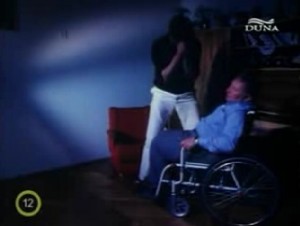 cute experiments in filmschool he just happened to make this extraordinarily shocking and stirring beautiful piece called (cca) How World had a fight after Jappe and Do Escobar. This was no filmschool film - it's a G-minor if thinking in Mozart terms. He used World War I footages and silent film footages plus footages he shot - in sets of that period too. He made the footage he shot look similar to archive stuff. What's this concept about? He didn't only want to show something that conducts the current of the story, he didn't only want to show footages like flat steps in order to cross - but rather he turned to the true and deep magic of film and he opened up all these footages in their true and big and RAW contexts blowing us away in waves of the released beauty. The story became all that came out of these footages like genes from their bottles. The story became much bigger and much wider than two teenagers' duel in a bath town.
cute experiments in filmschool he just happened to make this extraordinarily shocking and stirring beautiful piece called (cca) How World had a fight after Jappe and Do Escobar. This was no filmschool film - it's a G-minor if thinking in Mozart terms. He used World War I footages and silent film footages plus footages he shot - in sets of that period too. He made the footage he shot look similar to archive stuff. What's this concept about? He didn't only want to show something that conducts the current of the story, he didn't only want to show footages like flat steps in order to cross - but rather he turned to the true and deep magic of film and he opened up all these footages in their true and big and RAW contexts blowing us away in waves of the released beauty. The story became all that came out of these footages like genes from their bottles. The story became much bigger and much wider than two teenagers' duel in a bath town.
Of course, the Dog's Night Song could be looked at like a young a fresh and talented artist's great work which is very hard to copy because it's so original. Could be looked at like  Mozart's Don Juan - like a great and wonderful "piece" that just came out from this extremely talented source:) Could be - but we'd be missing the point. Imagine two-dimensional flat creatures walking and living in their flat world they'd be very much surprised by any encounters of stuff in 3 dimensions. Just think of a sphere - which appears for them now as a point and now as an ellipse which is changing its shape vividly - now it's here, now it's gone - and now it's there. Incredible phenomenon - very hard to find out about its nature and how it works. For even a child however who lives in a 3D world it's as simple as that: it's a dotted ball, popping on the ground :)
Mozart's Don Juan - like a great and wonderful "piece" that just came out from this extremely talented source:) Could be - but we'd be missing the point. Imagine two-dimensional flat creatures walking and living in their flat world they'd be very much surprised by any encounters of stuff in 3 dimensions. Just think of a sphere - which appears for them now as a point and now as an ellipse which is changing its shape vividly - now it's here, now it's gone - and now it's there. Incredible phenomenon - very hard to find out about its nature and how it works. For even a child however who lives in a 3D world it's as simple as that: it's a dotted ball, popping on the ground :)
If we look at this film like that everything becomes very natural very simple to comprehend. Gabor Body "just" decided to make a sociographic film (on the basis of his friend's Vilmos Csaplar's short story entitled: Sociography :)). Otherwise - like looking at this film as "only" a brilliant new 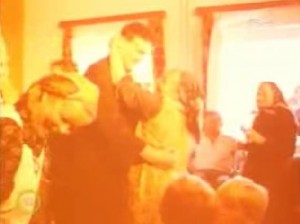 Hungarian one - we could just stand stunned, amazed by how magically he could make every detail of this film FIT so brilliantly, that you couldn't add nor to could take anything away from it - cause it's just perfect like this. And really not only as a whole - but all the details. What happened here? Mr. magician went into a huge project and used his supernatural gift to create a picture of Hungarian reality so rich in details like no other film ever before? Is this really where his art lays - in the details?
Hungarian one - we could just stand stunned, amazed by how magically he could make every detail of this film FIT so brilliantly, that you couldn't add nor to could take anything away from it - cause it's just perfect like this. And really not only as a whole - but all the details. What happened here? Mr. magician went into a huge project and used his supernatural gift to create a picture of Hungarian reality so rich in details like no other film ever before? Is this really where his art lays - in the details?
In like paying attention to all those details, all those competing motives of this semiotically black-belt concerto at all different levels of the audio-visual happening?
For a 2-dimensional creature yes but otherwise not - absolutely positively NOT. Gabor Body is not the artist of the details but that of the whole. What appears in 2 dimensions as a very complicated work of art being extremely well done and perfect and rich in details is actually a very loose and elegant expression. Instead of being a hard work it's just light and simple - like a Coltrane tune (or Mozart)). It reflects Gabor Body's cosmic playfulness.
Gabor Body's work with this film was not to build up a world from details - but rather to find the original thought, the Platonian "idea" of this film from and around which the whole project would just unfold. The actual filming was like developing this idea, developing the film. Details were not composed from the base going upwards but rather the original idea was governing all of them from the top going down to the smallest details. This is actually not the usual way filmmakers go about filmmaking:)
What usually happens is that there is a story from which they write the script - a series of scenes that give out the story. They even make a difference between the main shots of a scene and stuff in between which doesn't involve the main characters (that is second unit). Usually the story is everything, the story dominates over everything. It's a team work - where everybody serves the boss. Film-editors in the "darkroom" of the production "developing the film" will try their bests to make the story the most visible, the most powerful. This is about 2-dimensional film. That's about the stage in the garden - in the SeaGull.
As with Gabor Body's film it's simply and totally different. He doesn't shoot in order to get the shots that will make up the scenes which will tell the story. He shoots "scenes" that he just believes would be supporting the bigger 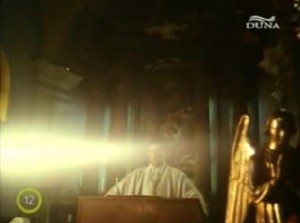 story, the wider-context story, the SeaGull. He doesn't care much about the stage in the garden - about telling the story of the fake priest as a line of actions. If it was a line of actions you'd see him enter the house, buy breakfast, wait for a phone call, etc. Instead he has the priest and the rest of his characters like components in his experiment. The experiment is like drilling for oil. He has a concept, a plan, then makes the drilling and waits to see if oil bursts up. The whole film-shooting is a series of drilling sessions. Success of a session is oil, that is that the scene works, the scene has the weight, the energy and the depths so it could be a "keeper".
story, the wider-context story, the SeaGull. He doesn't care much about the stage in the garden - about telling the story of the fake priest as a line of actions. If it was a line of actions you'd see him enter the house, buy breakfast, wait for a phone call, etc. Instead he has the priest and the rest of his characters like components in his experiment. The experiment is like drilling for oil. He has a concept, a plan, then makes the drilling and waits to see if oil bursts up. The whole film-shooting is a series of drilling sessions. Success of a session is oil, that is that the scene works, the scene has the weight, the energy and the depths so it could be a "keeper".
Usually filmmakers in the editing room look for the best versions of a scene or parts of a scene. Scenes will have their almost fixed places in the story.
As with Gabor Body he'd rather look for scenes that work. His mind is totally open. His scenes don't have to fit a story-line, the main idea is a much higher priority to story-line. He would never put a scene into a film just to make the story complete (that makes him different to just about every filmmaker who usually look for best available versions of their scenes and only give it up in case it's really not working) . With Body a scene would only make it to the film if it's perfect. His scenes serve the original idea (the research) and only that - not the/a story-line.
:: vision
This way of making a film is a very risky business. His original idea has to be something revolutionary already, it has to be a breakthrough, it has to be a key that'll open up and unfold everything - or just nothing will happen. It's double or nothing. Just like a good photographer who can find an angle to capture reality the way that the picture would be a revelation - the greatness of Gabor Body is somewhere about his incredible talent that he can develop a view on a subject by the means of his cognitive thinking (let's not be surprised - he's a brilliant philosopher! and artist of thinking!:)) that will turn out to be a sticky one - the most basic one. 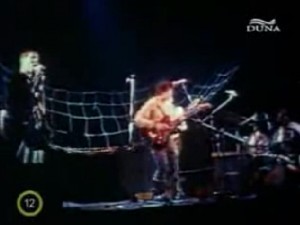 When you think of that subject - you'll have to think of that picture. A director with a vision - that's what you call it today.
When you think of that subject - you'll have to think of that picture. A director with a vision - that's what you call it today.
Dog's Night Song is based on a very simple idea: Hungary is a place behind god's back, a potential target of (Christian) missions - meaning that people in Hungary live below the standards of human conditions. People in Hungary suffer from what surrounds them - and hurt eachother. This very simple original thought like "socialism is a very bad thing killing the souls of people" wouldn't have been very much help for any other filmmaker to make such a wonderful film. Having a vision is only interesting because we suppose that it comes with having a key to this vision too. Gabor Body was able to see reality in a very intense way. He was very sensitive and poetic. He was a fragile poet but armoured with the skills and means and power of an army general. He was like a lunatic - powered with a razor sharp and clear mind of a philosopher. He was able to go to the deepest in dreaming and yet seeing it all fully awake and so being able to bring it all up. Speaking of being sensitive: he didn't kill himself - just for the records, so that you know.
:: relation to reality
The scenes, the sessions were very simple: characters confronting with eachother. The priest and the communist in the wheelchair, the beautiful blonde and her husband who's an army officer, the kid and his father, the kid and the astronomer, etc, etc. This film is a series of psycho-dramatic episodes between the characters colliding in a given scene. Psycho-dramatic scenes, yes, also meaning big space for improvisations. Characters - almost everyone of them - had their real last names: János, Mari, Attila.
This is a real game - this is a real risk-taking: Everything is so close to reality - and still he presumes that his original thought, his original idea, his vision, his concept can overcome - and lead to a remarkable result. We can say that his his vision was the product of his being over the reality. He could have a view on it already at the moment of living it. It's like being in a trance. He could see it like from the future - see it for what it really was (to most of us this only happens when we are in a new phase of reality).
This is not the first time for him to be so much ahead to most of the people with reality and making a complete fool of the socialist regime. About 11 years before he made a short documentary "Ifivezetők" (cca: Young Communists) in which the old former young-communists gather in like a hunting house and talk about their past - when they were young - young communists. They thought that this young filmmaker was on their side. They didn't notice how he "made a fool of them" - which was actually no fool-making - but making a crisp and crystal sharp documentary about how those people thought and lived. They didn't notice that this young guy came already from the future - they couldn't because they didn't have a view on it. They were happy with this documentary - but wouldn't be so now. The film did no cheating - its a high fidelity documentary. It just had this trick to it that Gabor Body was not living in that reality - he was only visiting like in a zoo. He made a drilling. Had concept and pushed himself into this situation to interview and film these people - hoping that the results would be revealing. And so they were: you see these old young-communists throwing fume-cartridges like at a military training - and you're just being amazed and think oh, my god! how could he possible make them do this in front of the camera?(!!!). The answer is easy and simple - doing it however is not simple at all. It's that he didn't make them do anything - he was acting as a catalyst. As a philosopher - who helps them find the truth. He "just" made them do what there was in them hidden. He "just" had brought that out from them - as a catalyst.
in which the old former young-communists gather in like a hunting house and talk about their past - when they were young - young communists. They thought that this young filmmaker was on their side. They didn't notice how he "made a fool of them" - which was actually no fool-making - but making a crisp and crystal sharp documentary about how those people thought and lived. They didn't notice that this young guy came already from the future - they couldn't because they didn't have a view on it. They were happy with this documentary - but wouldn't be so now. The film did no cheating - its a high fidelity documentary. It just had this trick to it that Gabor Body was not living in that reality - he was only visiting like in a zoo. He made a drilling. Had concept and pushed himself into this situation to interview and film these people - hoping that the results would be revealing. And so they were: you see these old young-communists throwing fume-cartridges like at a military training - and you're just being amazed and think oh, my god! how could he possible make them do this in front of the camera?(!!!). The answer is easy and simple - doing it however is not simple at all. It's that he didn't make them do anything - he was acting as a catalyst. As a philosopher - who helps them find the truth. He "just" made them do what there was in them hidden. He "just" had brought that out from them - as a catalyst.
The Dog's Night Song is really like Ifivezetők - he again made a complete fool out of everybody on the regime's side. They thought that they got themselves a new contemporary Hungarian film - but what they really got was an enormous tableau - an extraordinary research on how bad and how dead Hungarian life and reality is. This was an utmost experiment - with totally shocking results. All his test-scenes resulted "positive" - all the alerts light were blinking - all the drillings resulted in black fluid bursting out from the holes. He was like a medium, an agent of the future who "came back" to make this huge session - this huge research - to produce a view on how life is how things are. This study, this research is not a funny movie, not a "mai magyar" (contemporary Hungarian piece) - but something that the regime had better buried right away deep under the ground. They didn't because they didn't have the chance to realize what this film was about. Hungary being so down that it became potential target for missionaries ... this is not only a line in the film - but a conclusion of almost every scene. They shouldn't have let this film ever come out :)
Of course the priest smokes (!!:)) and he's a cheater(!!:)), he doesn't get upset seeing a ruined bible and speaks of Stalin as of a saint of communist regime adding that Church had popes and saints like him too. Also he's sort of guilty in helping 2 people kill themselves. And in the end the army-officer father gets together with his son:) These were enough for the regime to eat it. They just didn't get the point :) They didn't realize that they let a spy from the future do a study on their inhuman regime. They were watching this film as a 2-dimensional one - looking at the "story-line" - looking at scenes as those in a feature film - and not like footages from a documentary. They didn't see the wider story what this cosmic eyed newsreel was telling. This is really a spy movie. Exploring reality. It's a very low budget film (it was the lowest of its time), flying deep below the radars but carrying out a huge mission - following a concept, systematically creating a view on life and reality of the present.
:: the characters
He didn't write the "script" that he would have had to serve and follow. He just had his vision (about Hungary where everything is rotting and people suffer from the absence of love and hurt eachother a lot and howl like dogs at full moon - that is the bad conscience of socialism) and got himself a few characters and he only had to push them down the slope and see what happens as they collide. It's truly an experiment - a sociological one. Had his characters like Attila the astronomer had the photographic plate into the telescope's camera in the observatory "to collect the light of stars" - they are the open surfaces which collect the syndromes of human reality. He had his characters as indicators - (I've red this somewhere: he used his characters as "lacmus paper") to react to reality. They are tools for his research - drilling heads.
:: the camera
The other half of his concept for this film is the concept of cinematography which by this time has become equal to the "cosmic eye" - his original visual concept, visual philosophy. Now we can see this concept at work - and it's just amazing. It's about looking at things totally without a context. Just like you were an alien. Can you maybe remember how beautiful or scary some things were when you were a child? When a sign like "fragile" could mean a whole world .. (this example comes up because when Gabor Body showed his first feature, the American Torso to Sandor Weores, the wonderful poet Weores said in the end: I liked it! there was this box in it with the title "fragile", I really liked it! Only a child will say that - and a truly original poet. The concept of "Cosmic Eye" is something like this - to see things for what they really are - without the scum of civilization.
Gabor Body was actually practising, training himself of this art of looking at things thru the camera like people would by the time camera was invented (see the Sea at Dover - one of the first rolls ever made - his example). This, of course, reminds us of Yehudi Menuhin who was practising listening to and making music that was not based on the equal tempered scale.
Dog's Night Song has a director of photography who doesn't speak Hungarian - and so she wouldn't be able to directly react to whatever has been said. She's an outsider. Johanna Heer's photography in Dog's Night Song is just so unique and beautiful. It's thrilling. Just think 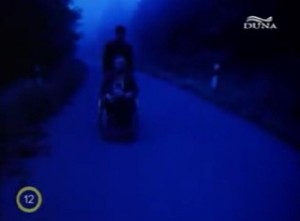 of the scene when Gabor Body as the priest is letting the old man go free downhill in his wheelchair. This scene in itself is something transcendentally familiar. Letting go of the old man and then catching him again - laughters of friendship and childishness. This cosmic playfulness is so typical of Gabor Body. But then again it's totally philosophical - since it's the synonym of the needle that is causing pain for that girl and so helps her digging up the truth. The needle goes on its way - to end up going into her heart. The wheelchair does that too - the old man wanted to die by letting himself roll downhill free. The priest came to help him - they talk, and they keep tasting the downhill rolling - and in the end he'll have his final go at it. The priest helped them like a catalyst finding the truth - their conclusion - their destination - causing their deaths - which is illegal. Those rolling scenes are just everlasting moments of both cinema and Gabor Body's presence.
of the scene when Gabor Body as the priest is letting the old man go free downhill in his wheelchair. This scene in itself is something transcendentally familiar. Letting go of the old man and then catching him again - laughters of friendship and childishness. This cosmic playfulness is so typical of Gabor Body. But then again it's totally philosophical - since it's the synonym of the needle that is causing pain for that girl and so helps her digging up the truth. The needle goes on its way - to end up going into her heart. The wheelchair does that too - the old man wanted to die by letting himself roll downhill free. The priest came to help him - they talk, and they keep tasting the downhill rolling - and in the end he'll have his final go at it. The priest helped them like a catalyst finding the truth - their conclusion - their destination - causing their deaths - which is illegal. Those rolling scenes are just everlasting moments of both cinema and Gabor Body's presence.
The camera lives her own life. Nothing is obligatory for her. Has her own logics. Sometimes you won't see any of the two characters in the scene, sometimes you will. Beautiful. Strange. Weird. Sensitive. So new! Even today.
:: video in the film
Gabor Body was very happy about using video and Super-8 footages in this film. What could have been his point? Why was it such a great thing?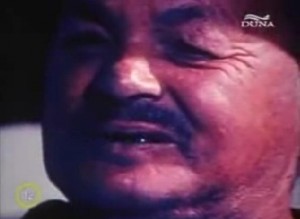 Using new technology - was that it? No, not at all (S8 wasn't even new). Mixed media for him was much rather: applying a new aspect. The point about video was that he could do an underground art research - by video - recording underground groups at concerts. This was a great enterprise too - very typical of Gabor Body. What video meant for him was the capability to penetrate to such hidden underground cultures where cinema's 35 mm research-tool would no way get in. Video could reach to down there and capture reality - and by using video he was able to show that reality on the silver screen (it's like bringing up pearls from extreme depths). Usually cinema is dragged way behind reality - and also in the beginning of the 80's video was still a very new thing. Today anybody who goes to a concert will have a handycam with her or him. Back then it was totally new. At that time having motion-picture recordings of concerts was a privilege for a band. If television decided to be interested in a band they'd record it. This means that you'd see a band on tv screen after they got really famous. Video was a revolution this way - Gabor Body could decide to record his friends - which was equal to writing history of art. No wonder why Gabor Body thought of the importance of video as that of Gutenberg's invention of book printing.
Using new technology - was that it? No, not at all (S8 wasn't even new). Mixed media for him was much rather: applying a new aspect. The point about video was that he could do an underground art research - by video - recording underground groups at concerts. This was a great enterprise too - very typical of Gabor Body. What video meant for him was the capability to penetrate to such hidden underground cultures where cinema's 35 mm research-tool would no way get in. Video could reach to down there and capture reality - and by using video he was able to show that reality on the silver screen (it's like bringing up pearls from extreme depths). Usually cinema is dragged way behind reality - and also in the beginning of the 80's video was still a very new thing. Today anybody who goes to a concert will have a handycam with her or him. Back then it was totally new. At that time having motion-picture recordings of concerts was a privilege for a band. If television decided to be interested in a band they'd record it. This means that you'd see a band on tv screen after they got really famous. Video was a revolution this way - Gabor Body could decide to record his friends - which was equal to writing history of art. No wonder why Gabor Body thought of the importance of video as that of Gutenberg's invention of book printing.
VHK (the Galloping Coroners - "Coroners On The Run" would be a much better translation though) was the main component of inspiration for him. An astronomer who's a punk at the same time is a motive of great sociographical significance - like a closing up of a cycle - the lowest layer of society meets the highest and react the same negative way to reality - quite a syndrome for a researcher like Gabor Body to start drilling. A group performing music that is like dog's  howling at full moon could serve as a very strong component to start with adding to a socio-documentarist-feature film. When you're watching their first footage in the film you're possible watching what must have been the triggering experience for him to start this whole project.
howling at full moon could serve as a very strong component to start with adding to a socio-documentarist-feature film. When you're watching their first footage in the film you're possible watching what must have been the triggering experience for him to start this whole project.
Video made it possible for him to create a film that had a so far totally invisible underground culture, an alternative ("parallel") culture appear on the silver screen. This is not only significant in terms of history of art - but also this could add such a huge charge of energy to this film that people could never have experienced before.
We already talked a great deal about making components collide in this film - well, the two biggest component for confrontation-tests are most definitely the official culture (socialism) and the alternative culture (culture of humans, culture of artists). Thanx to using video alternative culture can be on screen next to official culture and this collision, this comparison provides us with a fantastic view on reality - with the opportunity to understand and see both of them much more clearly in contrast with its counterpart - cause that's what they are to each other: counterparts.
That day underground music was not a product of entertainment - it was art in present tense continuous, happening at the moment. 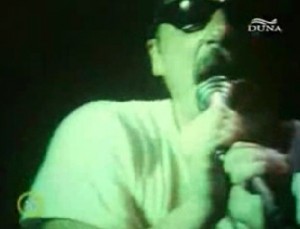 Putting the A.E. Bizottság - scenes in the film gave the audience quite an exceptional experience - this film exposed them to the highest level of art of that time. It was not the paintings, the fine art of the Bizottság members but their music, their words, their tunes, their body-movements, their intonations, their style in dressing, talking, looking - this was an incredibly intense dose from that reality, of that new way of living, of that lifestyle - it was revelation. That footage with that Bizottság song "még, még drágám!" is such a message, such a revelation from an strange culture. The guy (Laca feLugossy) wearing sunglasses is verbally having a sexual intercourse with the strange looking beautiful woman (Koko). They are way beyond the known reality. It's not a song. It's much more. They are performing something from a totally new world - a rite. It's revolutionary. It's new. It's a revelation.
Putting the A.E. Bizottság - scenes in the film gave the audience quite an exceptional experience - this film exposed them to the highest level of art of that time. It was not the paintings, the fine art of the Bizottság members but their music, their words, their tunes, their body-movements, their intonations, their style in dressing, talking, looking - this was an incredibly intense dose from that reality, of that new way of living, of that lifestyle - it was revelation. That footage with that Bizottság song "még, még drágám!" is such a message, such a revelation from an strange culture. The guy (Laca feLugossy) wearing sunglasses is verbally having a sexual intercourse with the strange looking beautiful woman (Koko). They are way beyond the known reality. It's not a song. It's much more. They are performing something from a totally new world - a rite. It's revolutionary. It's new. It's a revelation.
Gabor Body at first only intended to have the VHK footages - he realized it in the meantime how great Bizottság is and how wonderfully they fit in his project - in the end the song Kamikaze became the means of his self-expression - dancing to it at the FMK (Young Artist's Club) 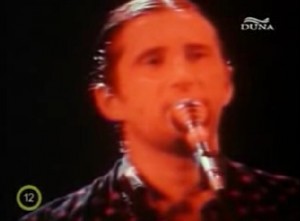 as the fake priest after having completed the mission. He loved Bizottság and each of the members so much - he was so happy with the footages that he put in the song "Szerelem" twice, and for the Kamikaze he did a somersault for Laca feLugossy saying that he could make even a whole new film with him. Bizottság and those wonderful artists were even new to him the top level artist - so now you can imagine how revolutionary it was for the audience to experience their art and their presence on the screen. That was video for him - the tool by which he could explore, capture and show reality from very-very close.
as the fake priest after having completed the mission. He loved Bizottság and each of the members so much - he was so happy with the footages that he put in the song "Szerelem" twice, and for the Kamikaze he did a somersault for Laca feLugossy saying that he could make even a whole new film with him. Bizottság and those wonderful artists were even new to him the top level artist - so now you can imagine how revolutionary it was for the audience to experience their art and their presence on the screen. That was video for him - the tool by which he could explore, capture and show reality from very-very close.
He also used video to record scenes of police investigation - in these cases video served as the means to achieve a very-very realistic style - closeups that showed all the the pores of the skin of somebody's face are just incredible depictions. What portraits these are! - What an intense way of seeing a person in a  very materialistic way - its like abusing them. And that interview with the real priest ... whose eyes are off the screen ... it's just something you'll never be able to forget ... Any time later (meaning more than 20 years) - when you see that actor (Frigyes Hollósi) you'll just see that priest in him - in that closeup. It's just so extraordinary - but not because it's unusual ...but because he doesn't care about being usual or unusual he just finds the perfect - the most incredible way to make that shot. It's very likely however that these eyes didn't fit in the frame by accident - because they set the video for too close - but still, accidents like that just don't exist. A very intense depiction of human sin and seeking the light of truth, the fight of flash and spirit in a way like down to earth materialism vs. seeking purity. What Bosch's character is with his hand stabbed through by a knife for gambling that is Body's eyeless portrait of the priest at the interrogation for sin and socialism. Incredible. Just so incredible.
very materialistic way - its like abusing them. And that interview with the real priest ... whose eyes are off the screen ... it's just something you'll never be able to forget ... Any time later (meaning more than 20 years) - when you see that actor (Frigyes Hollósi) you'll just see that priest in him - in that closeup. It's just so extraordinary - but not because it's unusual ...but because he doesn't care about being usual or unusual he just finds the perfect - the most incredible way to make that shot. It's very likely however that these eyes didn't fit in the frame by accident - because they set the video for too close - but still, accidents like that just don't exist. A very intense depiction of human sin and seeking the light of truth, the fight of flash and spirit in a way like down to earth materialism vs. seeking purity. What Bosch's character is with his hand stabbed through by a knife for gambling that is Body's eyeless portrait of the priest at the interrogation for sin and socialism. Incredible. Just so incredible.
It's also worth mentioning that using video for these scenes was not a way of using cheap technique or having a low-key shooting day. He wanted to have these scenes shot on video. He wanted to have that quality of the image. It was his weapon of choice:)
:: Super-8
Super 8 was also a concept - what's more: it was probably the very center of is concept. Super 8 was really the means for him to achieve that high level visual intensity he was seeking. 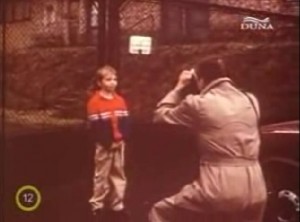 With S-8 he could make his film at some points be fully and purely visual - without any hints, any dramatic handles. At these moments you'll become familiar with his "cosmic eye" concept. Beautiful music - "Europa ist Amerika" makes it a visual Sturm Und Drang :)
With S-8 he could make his film at some points be fully and purely visual - without any hints, any dramatic handles. At these moments you'll become familiar with his "cosmic eye" concept. Beautiful music - "Europa ist Amerika" makes it a visual Sturm Und Drang :)
It's about travelling and looking at the world - with a very fresh eye. Before making this film Gabor Body was actually practising with Super 8 (!) to see the world from the most possible cosmic way - to see the things without their context.
In this film he gives us beautiful demonstrations of his "Comic Eye"- experience - but they have a very practical function too. Time after time they'll take the flow of the "story" and lift it to the heights of being purely visual. These waves will make you to adopt and see everything in a different way. You'll be switched to a fully visual mode. You just had your training and now you'll be much more open to whatever you see. Your eyes will be set free and appreciate their freedom, they will forget to keep a distance anymore, and it'll be just like making love visually. You'll become open and watch the rest of the film like that.
The dog and the chickens (especially with the chickens jumping - Gabor Body's cosmic playfulness) -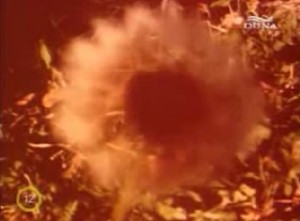 the most beautiful part - and the dandelion - that is the the centre of the visual universe. The music gets like a Kraftwerk song and the horse-shot is a real pinnacle. It's ever so beautiful - its just intense beauty. Making you wish you could be travelling with Gabor Body (which is a stupid thing since you're just doing it).
the most beautiful part - and the dandelion - that is the the centre of the visual universe. The music gets like a Kraftwerk song and the horse-shot is a real pinnacle. It's ever so beautiful - its just intense beauty. Making you wish you could be travelling with Gabor Body (which is a stupid thing since you're just doing it).
You see Olie (the German guy) actually spying, he says: "everything film" ("minden film"). With that S-8 camera he's taking samples of reality. Magazines, pictures on the wall, articles in the magazine, old factory, everything.
You see Olie (the German guy) actually spying, he says: "everything film" ("minden film"). With that S-8 camera he's taking samples of reality. Magazines, pictures on the wall, articles in the magazine, old factory, everything. You see Olie but it's actually Gabor Body. Recording reality - pictures on the wall, Pécsi Ildikó, somebody else, Zoltán Latinovits. What could this feel like for him to see this picture on a maximum socialist wall - this picture of his highly respected person (time didn't give him space for getting friends with him. Now, shooting a film about the socialist reality that actually killed Latinovits there's his picture on the wall of a countryside cultural centre which serves as a movie theatre too. What could this feel like? A moment of silence here.
The Super 8 camera is actually a character, an independent component of Gabor Body's concept for this film. By that time only the in the White Town had Super 8 in a remarkable way (a beautiful Alain Tanner film). He was number 1, just as with the clouds the clouds of Pscyhé which was first in the world together with Godfrey Reggio's incredible Koyaanisqatsi's cloud shots. Super 8 in Dog's Night Song represents the foreigner view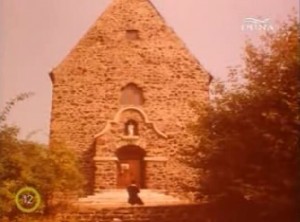 (that the kid will have to send back to Olie in the end because his father, the army officer doesn't like the idea of "peeping").
(that the kid will have to send back to Olie in the end because his father, the army officer doesn't like the idea of "peeping").
One of the two Gabor Body self-expressions in the film is recorded on Super 8 too - the scene with the wonderful Haendel piece "He shall feed His flock like a shepherd" when he comes out of the church and falls on his knees. This scene is so intense because we see him - as spies. He's not acting. We just see him and that's how he acts when he's alone: he's in trance he just loves people and beauty. There's also a funny part done on Super 8 - when he's sweeping the dirt off - after confessions :) That scene wouldn't be like Gabor Body if another component were not added to it - the girl with tuberculosis thorn her finger at a rose bush. She's like looking forward to get to the priest, these are her last moments before "engagement" :)
The third self-expression part in the film - the dream sequence is not necessarily a Super 8 shot, it looks like a 35 millimeter - with some tricks added. Still, because of the S8 camera's presence it'll qualify as anther Super 8 sequence. It's surreal. I mean you don't need to look for "coding":) The important motive is that the priest cries for help - because of the pain he suffers from helping.
Super 8 is also very important in the "story" since at the police when the kid is interrogated they show the same footages we have seen before - but police gives it a different context. Seeing the same footages thru the policemen's eye lets us compare again this and that world.
We can also say that the whole film took up a little bit the style of Super 8. He'll temper with the image to look exciting - to look sort of like Super 8. There's this famous scene in the kierkegarden for example - film burns out to white - and back to normal again and sound will follow it in a way. At around the end the "S00 0 - T90"-part also looks like Super 8 - even if it's not.
Cinema before Gabor Body was like a huge machine by which it was difficult to capture subtle layers of reality (like Godard did in Masculine-Feminine). Gabor Body - using Super 8 and video turned this big machine with low-resolution into a very fine and super-sensitive medium of art with extreme high resolution. High resolution means, of course, being able to capture more than just faces of movie-stars wearing fake costumes under huge lights in a studio. High resolution means that when 30 years later you watch a movie it'll have the details of reality - cars, furniture, clothes, styles, how they made money, how they spoke how they made love, how they thought of cars or weapons. High resolution means a sort of a cultural antropoligist aspect. Surely you can "go to the movies" to see something that'll make you forget your life - but cinema can be much more - it could be the means of gaining knowledge. Knowledge of the third kind - patterns for how to live and think - samples of how other people live and think and sense reality - not just "stuff" like whoever ran home at which game in the US at a given year :) Cinema can be the temple of empathy - and empathy can be like spice in the Dune - travelling without moving :)
:: a battle of two worlds – liberty leading the people
Dog's Night Song got its title from an early psycho- & socio-cinematographic experiment (Psychocosmoses) of his. That was actually not a film but a modelling of a film - feeding the characters with attributes like being aggressive or defensive and giving the situation a go to see what happens. Characters then start to react to each other and in the end they'll make up a formation, a layout as a final permanent phase. When the characters were acting defensively he called the layout as ~ "the garden of salvation" (or "salvage" if you like - in the original there's no religious sense - "menekvés kertje"). In the other version when characters were fed to be aggressive they were heavily hurting each other like piranhas - that situation he called "dog's night song". So on the basis of this experiment "Dog's Night Song" as a title was a short description of a situation - a symptom that the doctor identifies after examining the subject ...
Gabor Body was deeply interested in underground culture, he thought of it as of a parallel culture. He was totally engaged to it for example he organized a unofficial Hungarian cultural package for a foreign festival (to Scotland?) - that was typical for him, that was him. Dog's Night Song was like the Marseilles - like Delacroix's picture: Liberty Leading the people. It was revolution. This film got the official reality "collide" (now meaning: clash) with the unofficial one. This is a battle of worlds - for the soul of the woman and the kid.
The film has a "happy ending" - for the regime, for the system. But also it has a happy ending for those living in the 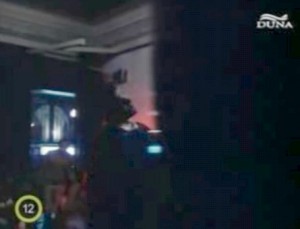 other world. For those who can only see 2 dimensions - it's a happy ending for the system. Otherwise it's the most deliberating film ever. The ending, I mean the last 10 minutes with the "S 00 Zero - T90" sequence is the fluid synonym of being free. Even the Kamikaze song with Gabor Body's dancing was like revolution - the state of totally and absolutely being FREE. This FREEDOM was exactly what the socialist system was depriving the human beings from. This FREEDOM was exactly what the socialist system was not allowing for anyone to have. Having and showing this state of FREEDOM was not only revelation anymore - but a rebellion.
other world. For those who can only see 2 dimensions - it's a happy ending for the system. Otherwise it's the most deliberating film ever. The ending, I mean the last 10 minutes with the "S 00 Zero - T90" sequence is the fluid synonym of being free. Even the Kamikaze song with Gabor Body's dancing was like revolution - the state of totally and absolutely being FREE. This FREEDOM was exactly what the socialist system was depriving the human beings from. This FREEDOM was exactly what the socialist system was not allowing for anyone to have. Having and showing this state of FREEDOM was not only revelation anymore - but a rebellion.
This film totally humiliated socialism and everybody on the system's side. It was more than a gravel in their sandal - it was a huge and frontal hit. They didn't even know it. They had no idea why and how this film was showing them like miserable officers of a ghost-army of Lenin, Stalin, Brezhnev & Kadar (the Hungarian big-name). 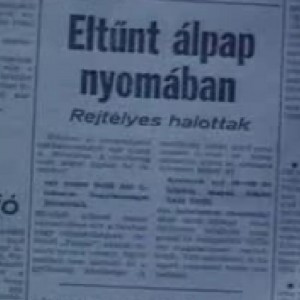 These people just didn't know what this film was about, what message it carried and how incredibly it humiliated their system. Gabor Body with his cosmic playfulness was their Dr. KHG (a character from a beautiful Istvan Örkény short-story). Like "A" did this to "B" in Kierkegaard's Either Or - he was watching all the drops on the sweating face of the regime. This film was a total and ultimate matt to the system. Many people got excited and started to want to enjoy their personal freedom too, and from the moment of seeing this film for many people the official reality looked only like a piece of used trash. You sow only "coffins from which even the corps had escaped" (Attila Grandpierre says this in the film).
These people just didn't know what this film was about, what message it carried and how incredibly it humiliated their system. Gabor Body with his cosmic playfulness was their Dr. KHG (a character from a beautiful Istvan Örkény short-story). Like "A" did this to "B" in Kierkegaard's Either Or - he was watching all the drops on the sweating face of the regime. This film was a total and ultimate matt to the system. Many people got excited and started to want to enjoy their personal freedom too, and from the moment of seeing this film for many people the official reality looked only like a piece of used trash. You sow only "coffins from which even the corps had escaped" (Attila Grandpierre says this in the film).
By the way: although the Kadar-regime is long over this film has not yet got the appreciation that a piece like this excelling in intellectual resistance and breaking down the communist-system would deserve (actually it did in Berlin - but not in Budapest) .. Dog's Night Song unlike many popular Hungarian film from the 80's and before - is sitting in a box - you can't buy it on DVD (nor VHS) .. can't even rent it - it's just not available ...
Every location from the film became hot cult - either the FMK (Young Artist's Club) or the doorway in the former Rajk László street with the title "Phoenix", or Aquincum with its the ancient Roman ruins where he and Attila Grandpierre were on the run - and green local trains were passing by too. Locations became hot cult - and music from the film became that too. Also lifestyle became cult - the way they spoke ... liken being in trance ... speaking the way Gabor Body did - became cult too - as well as his outfit - white trousers black sweatshirt or black jacket. Also religion became cult - many just realized that religion is just a great thing (not exactly what a socialist system want of you, right?:)). Marietta Méhes became so popular like actors and actresses in India - also András Wahorn who had a one line extra role to his wonderful performances of the song "Szerelem" and became like an idol for many - for all the young people.
The system got really pissed - Gabor Body and his art was exposed to very mean gossips (which was no news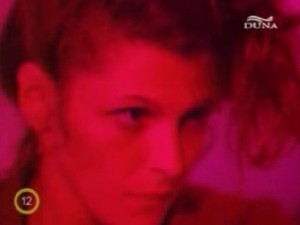 after he directed Hamlet and found himself in the middle of fire of bad tongues - seriously that adaptation of Hamlet you can see on video now and is amazing like practically anything Gabor Body did but he had to suffer from very mean campaigns). There were several main gossips that many echoed for long - one of them was that he finally learnt how to make a movie ... People loved him, everybody, everybody he ever worked or met with and anybody who never met with him - people loved his art, loved his films ... these mean gossips came from sources of the system ... They obviously realized it only later what they gave green light to without knowing it :) There was no script that they could have censored ... also it was very-very cheap so they must have thought small fly won't have a big byte ... the whole film looked "artsy" enough for them to understand and the priest did several gestures (the torn bible, the smoking, the "killing") that they must have liked ... while they had a very happy ending too ... the rest is silence - for them :) They were too slow to even get the humour of the film - like the army officer and his friend totally drunk singing "I can't get no satisfaction" - below a sign that say : "salve" (a working fragment of a neon sign). they didn't get this - so how could they ever possibly get what the ending part was - on the run?
after he directed Hamlet and found himself in the middle of fire of bad tongues - seriously that adaptation of Hamlet you can see on video now and is amazing like practically anything Gabor Body did but he had to suffer from very mean campaigns). There were several main gossips that many echoed for long - one of them was that he finally learnt how to make a movie ... People loved him, everybody, everybody he ever worked or met with and anybody who never met with him - people loved his art, loved his films ... these mean gossips came from sources of the system ... They obviously realized it only later what they gave green light to without knowing it :) There was no script that they could have censored ... also it was very-very cheap so they must have thought small fly won't have a big byte ... the whole film looked "artsy" enough for them to understand and the priest did several gestures (the torn bible, the smoking, the "killing") that they must have liked ... while they had a very happy ending too ... the rest is silence - for them :) They were too slow to even get the humour of the film - like the army officer and his friend totally drunk singing "I can't get no satisfaction" - below a sign that say : "salve" (a working fragment of a neon sign). they didn't get this - so how could they ever possibly get what the ending part was - on the run?
It was again Attila Grandpierre's art (who's actually a true and real friend for him - not just socially but spiritually too - and unlimited)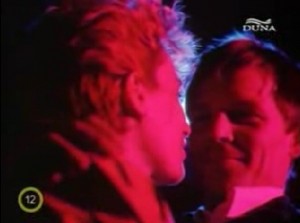 about a strange kind of catharsis - the lake, the moon, the trumpet and your own face. Beautiful. Extremely beautiful. With this poem that Attila Grandpierre told Veruschka Body (who was his girlfriend in the fiction) this whole ending part became like an art video - like a "lyric clip", a poetic video. The visual rhythm comes from that of the trombone solo (that stands for the trumpet). The "S 00 Zero" sign on the upper left corner of the frame is representing the opponent powers - the police of the socialist Hungary - having this wild goose chase after them. What makes this "clip" incredibly beautiful is that he (sitting together with the film editor, Anna Kornis in the dark room) realized how great it looks and what a rhythm it has to see those footages that usually nobody uses - when the camera speeds up (before camera man says" rolling") and when it slows down after it was turned off. These few second (1-2) long footages were only familiar to those who were filming with super 8. Now this little effect hit the cinemas. This speeding up that looks like what you see in music videos at the end of the 90's makes it totally poetic and once again the film gets in fully visual mode and you're forced to feel things only - without thinking. This pulsing end-part with the priest and the artist on the run with the ink-blue clouded night-sky in the background is a plain rebel ... They are leaving for the unknown ... Leaving a country behind the iron curtain just like that ... And yet - it's not about passports ... nobody cares about passports or police or borders .. it's just about catharsis ...
about a strange kind of catharsis - the lake, the moon, the trumpet and your own face. Beautiful. Extremely beautiful. With this poem that Attila Grandpierre told Veruschka Body (who was his girlfriend in the fiction) this whole ending part became like an art video - like a "lyric clip", a poetic video. The visual rhythm comes from that of the trombone solo (that stands for the trumpet). The "S 00 Zero" sign on the upper left corner of the frame is representing the opponent powers - the police of the socialist Hungary - having this wild goose chase after them. What makes this "clip" incredibly beautiful is that he (sitting together with the film editor, Anna Kornis in the dark room) realized how great it looks and what a rhythm it has to see those footages that usually nobody uses - when the camera speeds up (before camera man says" rolling") and when it slows down after it was turned off. These few second (1-2) long footages were only familiar to those who were filming with super 8. Now this little effect hit the cinemas. This speeding up that looks like what you see in music videos at the end of the 90's makes it totally poetic and once again the film gets in fully visual mode and you're forced to feel things only - without thinking. This pulsing end-part with the priest and the artist on the run with the ink-blue clouded night-sky in the background is a plain rebel ... They are leaving for the unknown ... Leaving a country behind the iron curtain just like that ... And yet - it's not about passports ... nobody cares about passports or police or borders .. it's just about catharsis ...
Most of the artists keep searching till s/he finds something ... something that works ... a way to express him/herself ... his or her tone or way or style ... to settle like a satellite on orbit and do broadcasts on that tone as a station - till the end of time. Gabor Body didn't settle, he made this film - and practically had finished with Hungary. 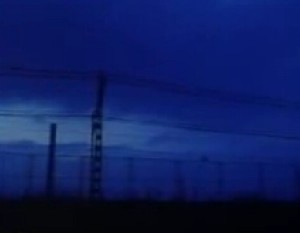 This run in the end stood for "thanx and bye". From then on he lived half way in Berlin and his wonderful video projects he just did there - and didn't ask anybody from Hungary for money. For his next two feature film projects (Fiery Angel and "Psychotechnikum") he was turning to ZDF and other western organizations. He was not a guy from Budapest in Berlin but became an ambassador of (West) Berlin in Budapest - which totally fit his mission - searching the future in terms of expressions and the means of it ... like the video ... Dog's Night Song was not a beginning - it was the end - of a phase (he didn't kill himself) - from which in Berlin a multiple set of bright new horizons opened up already ... So everybody could stay and wait thrilled - waiting for the next great thing ... Yes, it was a beautiful year - the most promising one ...
This run in the end stood for "thanx and bye". From then on he lived half way in Berlin and his wonderful video projects he just did there - and didn't ask anybody from Hungary for money. For his next two feature film projects (Fiery Angel and "Psychotechnikum") he was turning to ZDF and other western organizations. He was not a guy from Budapest in Berlin but became an ambassador of (West) Berlin in Budapest - which totally fit his mission - searching the future in terms of expressions and the means of it ... like the video ... Dog's Night Song was not a beginning - it was the end - of a phase (he didn't kill himself) - from which in Berlin a multiple set of bright new horizons opened up already ... So everybody could stay and wait thrilled - waiting for the next great thing ... Yes, it was a beautiful year - the most promising one ...


